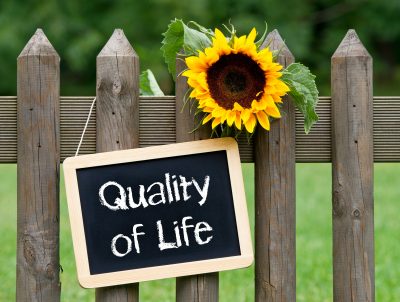
Nursing homes often stress that they strive to maximize the quality of life for those elders who reside there. Over the years I’ve heard the term quality of life so many times that it seems rather vague now. Has it become an overused phrase that lacks a meaningful context? What is it anyway and how do we know when we’ve achieved it for anyone other than ourselves?
Quality of life is hard to define, therefore we all have our ideas about it. For one it may be associated with physical function or being pain-free. Yet the next person may stress having regular connections with family or friends. And still a third will say it’s having a clear mind and being able to engage in spiritual practice. The most basic definition I found states says that quality of life is “how good or bad a person’s life is.” I find that sufficiently vague to be meaningless.
So if the quality of life is subjective, then what matters most to individual residents in long-term care? One research article tells us that “The majority of the elderly people evaluate their quality of life positively on the basis of social contacts, dependency, health, material circumstances, and social comparisons.” Other researchers found that “dignity, spiritual well-being, and food enjoyment remained predictors of overall nursing home satisfaction.”
An especially exciting publication called Quality of Life: The Priorities of Older People with Cognitive Impairment reports that nursing home residents most value:
- Frequent contact with family
- Privacy and being able to spend time alone
- Socializing with others, including staff and visitors
- Being active
- Having meaningful activity
- Engagement in religious or spiritual practices
- The staff treats them with respect
- Feeling like staff members see them as individuals
In conclusion, there are many layers of daily existence to take into account when trying to measure if a person’s quality of life is at a high level or is lacking. The bottom line is that we really can’t judge it through our lens; however any attempt to know the person is in the right direction.
If you work in long term care, what’s something you do to help ensure each resident’s quality of life?
Ann Catlin, OTR, LMT: For twenty years, Ann led in the field of skilled touch in eldercare and hospice. She has nearly forty years’ clinical experience as an occupational and massage therapist. She created Age-u-cate’s Compassionate Touch program and serves as a Master Trainer and training consultant.

 Quite simply, the definition of personhood is the quality or condition of being an individual person. At the core of personhood is the self- who we are are, our values and beliefs. It’s who makes us who we are. Being able to recognize the “self” of personhood is key to understanding and practicing person-centered care for persons living with dementia.
Quite simply, the definition of personhood is the quality or condition of being an individual person. At the core of personhood is the self- who we are are, our values and beliefs. It’s who makes us who we are. Being able to recognize the “self” of personhood is key to understanding and practicing person-centered care for persons living with dementia. What exactly is the meaning of Life Enrichment?
What exactly is the meaning of Life Enrichment?